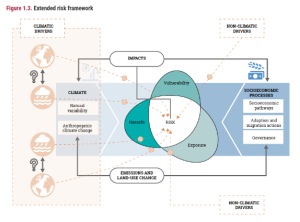About UN Global Assessment Report on Disaster Risk Reduction (GAR):
- It is the flagship report of the United Nations on worldwide efforts to reduce disaster risk.
- The GAR is published by the UN Office for Disaster Risk Reduction (UNDRR).
About UNDRR
- It is the United Nations system’s focal point for disaster risk reduction and the custodian of the Sendai Framework, supporting countries and societies in its implementation, monitoring and review of progress.
Sendai Framework on Disaster Risk Reduction 2015–2030
- It focuses on the adoption of measures that address all dimensions of disaster risk – hazard, exposure, vulnerability and coping capacity – to prevent the creation of new risk, reduce existing risk and increase resilience.
- It incorporates a strong focus on inclusiveness “through the implementation of integrated and inclusive economic, structural, legal, social, health, cultural, educational, environmental, political and institutional measures that prevent and reduce hazard exposure and vulnerability to disaster, increase preparedness for response and recovery, and thus strengthen resilience.
Sustainable Development Goals (SDGs)
- It sets out 17 SDGs and provides a comprehensive global policy framework towards ending all forms of poverty, hunger, inequalities among and within countries and tackling environmental degradation and climate change, while ensuring “no one is left behind”.
- The SDGs incorporate multiple Sendai Framework targets as well as climate change and sustainability targets.
Paris Agreement
- It steers action towards global climate change adaptation and the mitigation goal of limiting global warming to well below 2°C above pre-industrial levels, and preferably to 1.5°C.
India’s Effort: National Platform for Disaster Risk Reduction (NPDRR), 2013
- It aims to bring together the whole range of India’s disaster risk community from Government, Parliamentarians, Mayors, Media, International Organizations, NGOs, local community representatives, scientific and academic institutions and corporate businesses etc.
- It will help in sharing of experiences, views and ideas, present findings of research and action and explore opportunities for mutual cooperation in the field of Disaster Risk Reduction.
- The output will offer a strategic direction and a road map for the formulation of our future National Action Plans on Disaster Risk Reduction (DRR).
Coalition for Disaster Resilient Infrastructure (CDRI)
- It was launched by Indian Prime Minister during the United Nations Climate Action Summit in September, 2019, at New York with the support UNDRR.
- It is a multi-stakeholder global partnership of national governments, UN agencies and programmes, multilateral development banks , the private sector, and academic institutions.
- Aim: To promote the resilience of infrastructure systems to climate and disaster risks, thereby ensuring sustainable development.
- It supports countries to upgrade their systems to ensure disaster and climate resilience of existing and future infrastructure, in alignment with the Sustainable Development Goals, the Paris Agreement on Climate Change, and the Sendai Framework.
- Current Membership: 31 Countries, 06 International Organizations and 02 private sector organizations have become members of CDRI.
- HQ: New Delhi, India.
|
![]() 24 Jul 2023
24 Jul 2023

 Example: the economic and social costs of the pandemic in 2020, measured in lifeyears lost, far outweighed the average annual costs of other disasters, and the summed cost of all epidemics from 2000 to 2019.
Example: the economic and social costs of the pandemic in 2020, measured in lifeyears lost, far outweighed the average annual costs of other disasters, and the summed cost of all epidemics from 2000 to 2019.
